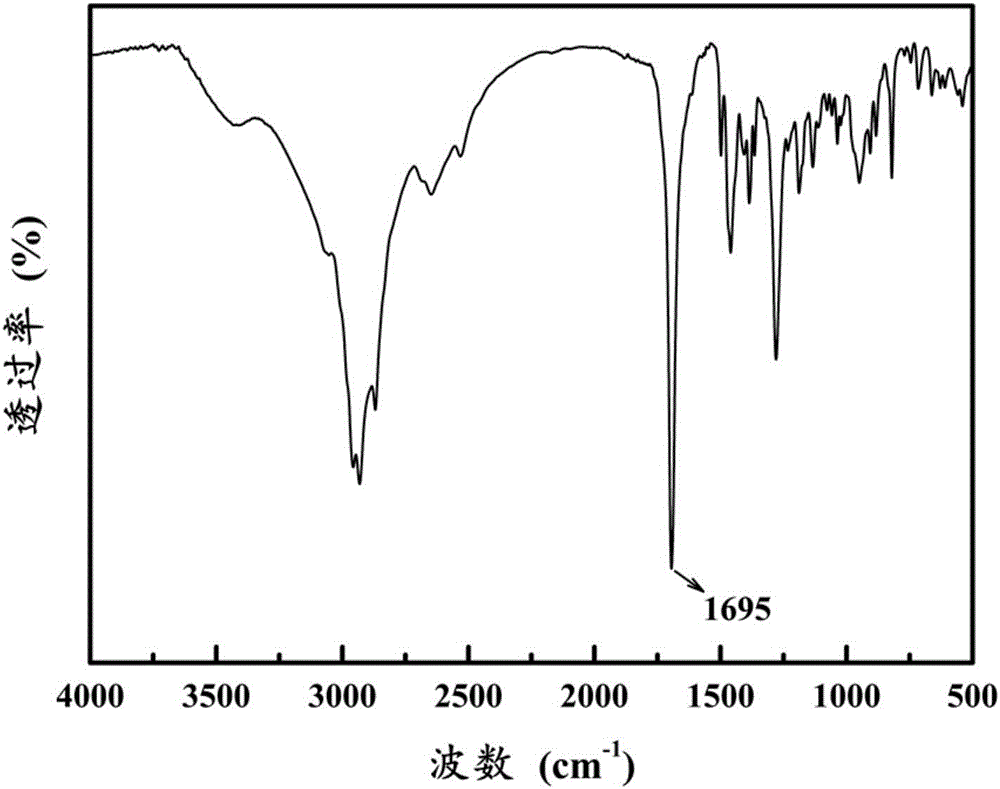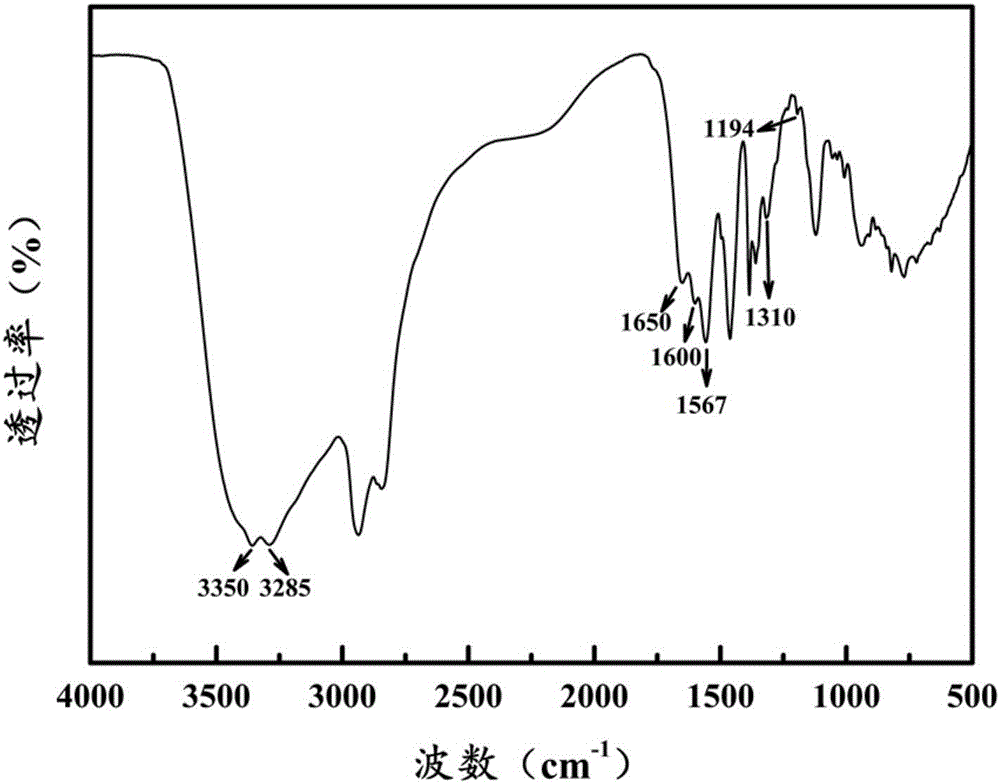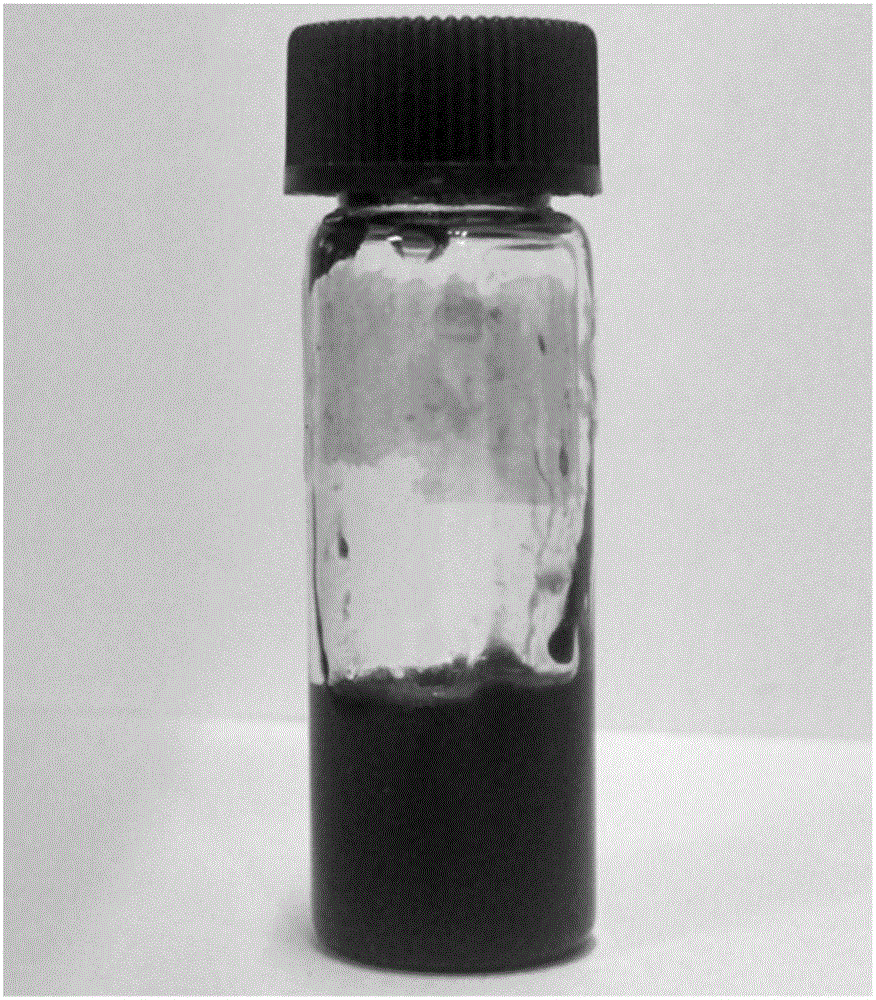Method of improving dispersity and interface compatibility of graphene in epoxy resin
A technology of interface compatibility and epoxy resin, applied in the field of epoxy resin curing agent and epoxy resin composite material, can solve the problems of poor dispersion, poor interface compatibility between graphene and epoxy resin, etc., and achieve high stability , Improve the interface compatibility, the effect of simple and easy operation
- Summary
- Abstract
- Description
- Claims
- Application Information
AI Technical Summary
Problems solved by technology
Method used
Image
Examples
Embodiment 1
[0028] 0.02g graphene oxide and 3g dehydroabietic acid are dissolved in 200mL ethanol by stirring and ultrasonic dispersion (ultrasonic frequency is 80KHz, ultrasonic power is 300W, ultrasonic time is 0.5h), and then the co-solvent ethanol is removed by rotary evaporation to obtain Graphene oxide / dehydroabietic acid powder. The graphene oxide / dehydroabietic acid powder was placed in 50 mL of hydroiodic acid and reacted at 120°C for 48 hours to obtain graphene / dehydroabietic acid powder. Graphene / dehydroabietic acid powder and tetraethylenepentamine (the molar ratio of dehydroabietic acid and tetraethylenepentamine is 1:2) were reacted at 160°C for 2h and then reacted for 4h at 200°C, then the temperature was lowered to Add a certain amount of acrylonitrile (the molar ratio of dehydroabietic acid to acrylonitrile is 1:3) at 50°C for 2 hours to obtain a stable monolayer or oligolayer liquid graphene / rosin-based polyamine with an amine value of 350mgKOH / g. Such as image 3 show...
Embodiment 2
[0031]0.02g graphene oxide and 3g dehydroabietic acid are dissolved in 100ml acetone by stirring and ultrasonic dispersion (ultrasonic frequency is 80KHz, ultrasonic power is 120W, and ultrasonic time is 1.5h), and then the co-solvent acetone is removed by rotary evaporation to obtain Graphene oxide / dehydroabietic acid powder. The graphene oxide / dehydroabietic acid powder was placed in 100ml of hydroiodic acid and reacted at 100°C for 24 hours to obtain the graphene / dehydroabietic acid powder. Graphene / dehydroabietic acid powder was reacted with triethylenetetramine (the molar ratio of dehydroabietic acid to triethylenetetramine was 1:4) at 160°C for 2h and then at 200°C for 4h to obtain the amine value 850mgKOH / g, stable monolayer or multilayer liquid graphene / rosin-based polyamine.
[0032] Graphene / rosin-based polyamine and E51 type epoxy resin are mixed in a mass ratio of 1:4 and then cured to obtain a uniformly dispersed graphene / epoxy resin composite material, and 0.1wt...
Embodiment 3
[0034] 0.04g graphene oxide and 6g dehydroabietic acid are dissolved in 250ml dimethyl sulfoxide (DMSO) by stirring, ultrasonic dispersion (ultrasonic frequency is 80KHz, ultrasonic power is 150W, ultrasonic time is 1h), then by rotary evaporation The co-solvent DMSO was removed to obtain graphene oxide / dehydroabietic acid powder. The graphene oxide / dehydroabietic acid powder was placed in 100 ml of ascorbic acid aqueous solution at 100° C. for 48 hours to obtain graphene / dehydroabietic acid powder. Graphene / dehydroabietic acid powder was reacted with isophorone diamine (the molar ratio of dehydroabietic acid to isophorone diamine was 1:2) at 160°C for 2h and then at 200°C for 4h, A stable monolayer or multilayer liquid graphene / rosin-based polyamine with an amine value of 248 mgKOH / g was obtained.
[0035] Graphene / rosin-based polyamine and E51 type epoxy resin are mixed in a mass ratio of 1:1 and then cured to obtain a uniformly dispersed graphene / epoxy resin composite mate...
PUM
| Property | Measurement | Unit |
|---|---|---|
| electrical resistivity | aaaaa | aaaaa |
Abstract
Description
Claims
Application Information
 Login to View More
Login to View More - R&D
- Intellectual Property
- Life Sciences
- Materials
- Tech Scout
- Unparalleled Data Quality
- Higher Quality Content
- 60% Fewer Hallucinations
Browse by: Latest US Patents, China's latest patents, Technical Efficacy Thesaurus, Application Domain, Technology Topic, Popular Technical Reports.
© 2025 PatSnap. All rights reserved.Legal|Privacy policy|Modern Slavery Act Transparency Statement|Sitemap|About US| Contact US: help@patsnap.com



